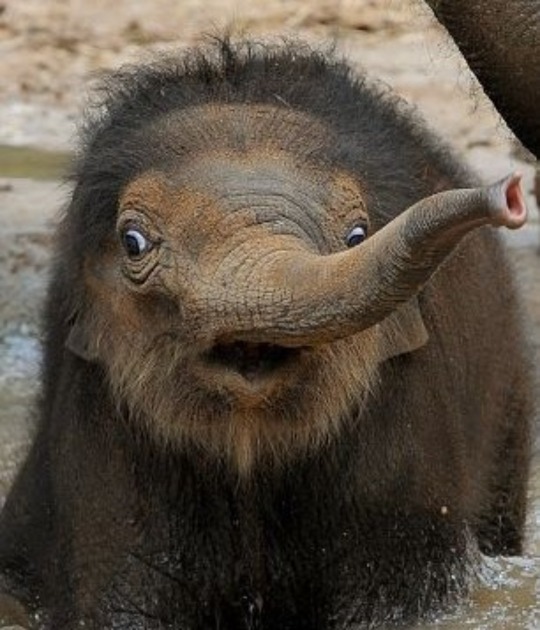#sumatran elephant
Text

My art print of Elephants is now available in my store. It includes all three species and also the subspecies. I know the Bornean Elephant is not yet a subspecies but I decided to include it because analysis indicates that it will be elevated as a subspecies soon.
Available here:
https://www.inprnt.com/gallery/rinunez/
Instagram here:
https://www.instagram.com/species_of_the_world/
#sumatran elephant#elephant#forest elephant#indian elephant#asian elephant#elefante#illustration#drawing#scientific illustration#illo#wild animals#wildlife#artist on tumblr#animals#artprints#artwork#mammals
38 notes
·
View notes
Text

A Sumatran elephant wanders the lowland tropical rainforests of Indonesia's East Aceh province.
Photograph by Regina Safri

#regina safri#photographer#elephant#animal#mammal#wildlife#sumatran elephant#east aceh province#indonesia#tropical rainforests#nature
21 notes
·
View notes
Text
Animal of the Day!
Sumatran Elephant (Elephas maximus sumatranus)

(Photo from Project Hope)
Conservation Status- Critically Endangered
Habitat- Sumatra
Size (Weight/Length)- 5 metric tonnes; 3 m in height
Diet- Leaves; Fruits; Bark; Grasses
Cool Facts- This forest dwelling Asian elephant subspecies is a gardener at heart. Helping to keep rivers clear of clogging plant life and spreading seeds of countless plants, the Sumatran elephant aids in keeping the forests of Sumatra beautiful. Sadly, due to extreme poaching for their straight tusks and deforestation, Sumatran elephant populations have dropped 80% in 75 years. With as few as 1,500 individuals and limited viable habitat left, conservationists are rushing to save the species. A massive national park of 1,000 square kilometers was created and is one of the last wild refuges for these gentle giants.
Rating- 13/10 (Could be gone in less than a decade.)
Animtober- Bluff (You might wet your pants, but it’s just a bluff charge.)
#Animal of the day#Animals#Mammals#Elephants#Thursday#October 20#Sumatran elephant#biology#science#conservation#the more you know#Animtober#Inktober#Bluff
113 notes
·
View notes
Text
Sumatran Elephant Daily Life.
#animal kingdom#wildlife#animals#wildlife documentary#wild animals#animal world#wildlife animals#wild animals short film#animal documentary#animals kingdom#animal planet#elephant#sumatran elephant#sumatran elephant documentary#sumatran elephant endangered#sumatran elephant sanctuary#sumatran elephant status#elephant whisperers#elephant video#elephant sounds#wildlife photography#animallovers
1 note
·
View note
Text
Sumatran Elephant
Facts

Sumatran elephants eat a wide variety of plants and scatter seeds across the jungle, helping to a healthy environment. They also share their lush forest environment with several other endangered species, including the Sumatran rhino, tiger, and orangutan, as well as countless other species that benefit from a healthy elephant population.
Website
STATUS: Critically Endangered
POPULATION: 2,400 – 2,800
SCIENTIFIC NAME: Elephas maximus sumatranus
HEIGHT: 5-9 feet at the shoulder
WEIGHT: approximately 5 tons
LENGTH: up to 20 feet
HABITATS: Broadleaf moist tropical forests
Why They Matter
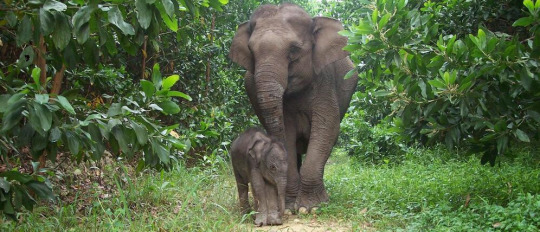
Sumatran elephants eat a wide variety of plants and scatter seeds across the jungle, helping to a healthy environment.
Threats
Deforastation and Habitat Loss
The Sumatran elephant was downgraded from "Endangered" to "Critically Endangered" in 2012 because half of its population was lost in a single generation, owing to habitat degradation and human-elephant conflict. Sumatra has one of the greatest rates of deforestation within the Asian elephant's range, resulting in local elephant extinctions in numerous regions. In the last 25 years, approximately two-thirds of the Sumatran elephant's natural lowland forest has been lost, and nearly 70% of the Sumatran elephant's habitat has been destroyed in a single generation.
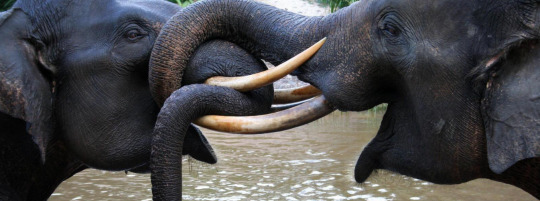
Pulp and paper businesses, as well as oil palm plantations, have produced some of the world's fastest deforestation rates in Sumatra's Riau province. In less than 25 years, elephant numbers have plummeted by 80%, restricting some herds to limited forest tracts. Long-term survival is unlikely for these populations. The number of elephant herds in Lampung province has decreased from twelve in the 1980s to only three in 2002. Biologically, only two of the remaining herds are considered viable.
Human Elephant Conflict
Elephants frequently come into touch with human communities as a result of Sumatra's fast urbanization and deforestation. They plunder fields, trample homes, and occasionally injure or kill individuals. Those who have been harmed may revenge by poisoning or shooting elephants.
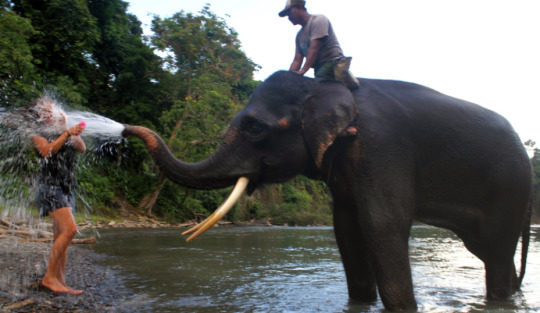
Poaching
The tusks of Sumatran elephants are normally smaller, yet they are enough to entice poachers to kill the animals and sell their tusks on the black market for ivory. Because only male Asian elephants have tusks, each poaching incident progressively skews the sex ratio, limiting reproduction rates for the species.
Website
#elephant#sumatran elephant#sumatra#asia#save the environment#environment#save the planet#save the earth#save the future#save the animals#animal welfare#animal protection#nature protection#nature welfare#wildlife
1 note
·
View note
Text



Miss Supranational Indonesia 2023 National Costume: THE WARRIOR OF WAY KAMBAS
Way Kambas is a national park in Lampung province which is home to the preservation of the Sumatran elephant and other animals that are now endangered. Way Kambas has saved hundreds of elephants. This costume represents a warrior who protects elephants which consists of silver, gray, white colours and a touch of blue "Tapis Lampung" traditional woven. Blue is inspired from the meaning of "tranquility, peace & protection". The cone-shaped skirt describes as a home and a safe place for elephants from poaching.
#Miss supranational#miss supranational Indonesia#Indonesia#pageant#national costume#national costume contest#miss supranational 2023
127 notes
·
View notes
Text
Public Service Announcement
Yes, I'm back! Missed me? :D
I don't know where to start, really. My last year of travels was both an incredible, life-changing, empowering, unforgettable experience, and the hardest, most challenging thing I have ever done (and probably will ever do) in my life.
In the space of a year I have visited 11 countries: New Zealand, Fiji, Australia, New Caledonia, Japan, South Korea, Singapore, Malaysia, Indonesia, Poland and Greece. Everywhere I went, I have always tried not to be a tourist, but live like a local, stay with the local people and have as many experiences as I could possibly grab a hold of.
I close my eyes and I can re-trace the exact route from Cashmere to the city centre of Christchurch, or I can still taste the Kava drink, or I remember exactly where to put my feet on the ascent to Yunomine Onsen via the Kumano Kodo Pilgrim Trail, or I can tell what Sumatran elephant skin feels like under my fingers, or which of the rice fields around Ubud offer best views without too many tourists.
I got to do everything I ever wanted, fulfilled every dream I ever had and then some, met some amazing people that will stay with me for the rest of my life, and frequently did 8 absolutely impossible things before breakfast. I travelled on local busses, bought my veggies from local bazars, had local supermarket loyalty cards, dealt with visas, made friends with people who didn't speak a word of English... It kinda made me fearless and unstoppable.
I've also struggled with depression, seriously questioned my life's choices, missed home insanely, been to paradise and hated it at times, doubted myself, and had a real reality check on what's important to me. And I regret none of it.
How do you pick up the pieces of your life after something like that?
The good news is that my love for this fandom has never left or diminished, and in fact it often provided to be a source of great comfort to me. I wrote stories in my head during my walks, I re-read some excellent old fics, I took Fili and Kili with me to some seriously remote places.
But I think the fandom has changed during my absence. And I have changed too. So as I sit down and re-think how I wanna indulge in my love of FiKi, here's what I've got:
I am seriously attached to three of my Verses (and have been focussing on them for a while), which I'd love to continue with: Silence, Isca and Postcards. There will be more posted, when I'm ready with it. Watch this space. Subscribe, maybe?
I have been writing mainly for myself for a number of years now and I can and I will continue to do so. But it's alwas a delight when someone else comes on a journey with you, so I'll continue posting publically.
GF is my Happy Place and I have missed it hugely, especailly as it hadn't continued to function as I hoped it would during my absence. I want to come back to tending that garden, as it's important to me. And I might take part in some events again, if the gods smile at me again, which will mean any and all verses will be considered.
I can't imagine in what possible universe I would have the time for drawing again. Having said that, I am sitting on some unpublished and unfinished artwork, some of it in collabs, and I know I can be stubborn enough to force their completion. Something to think about.
What else? I guess that's it. How have everyone been? What's new? WHO's new? Did I miss anything important? Come and say hi - I'm always happy to chatter.
21 notes
·
View notes
Note
Do you have any idea if there were rhinoceros in the Middle East during historic or recent times? Given that, as in some old posts of yours, big felines and elephants were widespread in those areas, the gap between African and Asiatic rhinoceros seems suspicious. Also, do you think that the extinction of large fauna in the Middle East is asociated to deforestation in that region? As I understand it, forests there were larger than in the present.
So sorry that I've only just now seen your message. (I accidentally came across your message when it was displayed to me when I was searching the keyword "rhinoceros" on my own blog.) Great question.
With confidence, I would say that the so-called Fertile Crescent was more densely wooded during the Holocene up to and during the Bronze Age. We know this not just from ecological and paleoenvironmental science but also from clear written historical records that describe the scale of the forests. Forests were so bountiful that, when cedars were cut down and harvested, and then floated down the Euphrates river for transport, the unending rafts of cedar logs appeared like giant snakes ungulating along the river.
Then, with less confidence, we can guess that rhinos would have been rare in southwestern Asia after the end of the Pleistocene, and would have gone extinct earlier in history than other large creatures.
Sounds like you already know that the Fertile Crescent, Anatolia, and southwestern Asia were home to elephants, tigers, lions, cheetahs, leopards, ostriches, and other celebrities in the Bronze Age and ancient worlds. But rhinos?
Basically, my guess is that rhinos could have been present in Anatolia during the construction of Gobekli Tepe and Catal Huyuk, and the rhinos would have been, I'm guessing, the now completely extinct genus Stephanorhinus. The youngest known remains of Stephanorhinus come from Siberia and the Far East, and appear to be between 40,000 and 14,000 years old. This means that we have no clear evidence that Stephanorhinus survived into the Holocene.
The Syrian elephant of the Fertile Crescent, in Hellenistic/Roman iconography:

Stephanorhinus, from the Late Pleistocene:

Stephanorhinus kirchbergensis and Stephanorhinus hemitoechus are known to have survived in Late Pleistocene Europe. They both seem relatively common in the Levant during the Middle Pleistocene. Remains of S. hemitoechus are known from Persia. Stephanorhinus also appears on the African continent in the Pleistocene, in modern-day Morocco and along the Mediterranean coast. But S. kirchbergensis seems like it may have been more associated with forests, so I’d guess S. hemitoechus had a better chance of surviving in early Holocene Middle East. I’ve also read that rhino biodiversity was more limited than other creatures by the end of the Middle Pleistocene, so there was less genetic diversity than other types of mammals. This rhino situation differs from the other disappearing megafauna, because the same species the other missing/extinct creatures (Syrian elephant, Caspian tiger, Asiatic lion, Syrian ostrich) still have living relatives within the same genus. But there are no surviving Stephanorhinus creatures left on the planet.
Short answer: remnant populations of Stephanorhinus hemitoechus may have been rare but still present during the early Holocene in southwestern Asia at the time of the construction of the first human cities. (Probably not during, like, Bronze Age, but earlier.)
Here's a look at the distribution range of the white rhino, black rhino, Indian rhino, Sumatran rhino, Javan rhino, Merck's rhino, the woolly rhino, and the legendary Siberian unicorn in the Late Pleistocene, in a map from 2021:
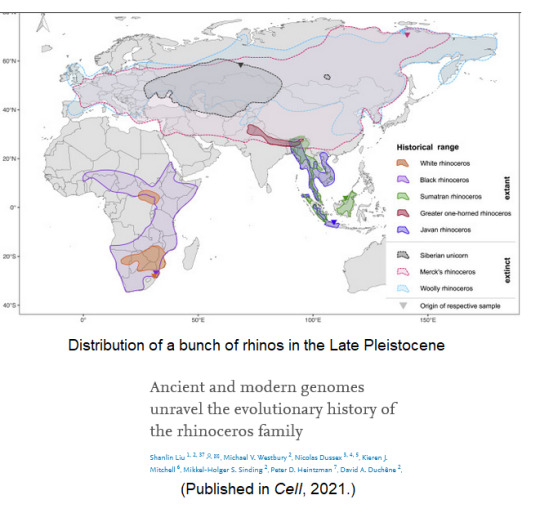
While the extant Asian elephant was once distributed outside of South Asia and into the west and the Middle East, as far as we can tell the extant Indian rhinoceros only lived as far west as the Indus and/or Bactria.
However, both the Javan rhinoceros and Sumatran rhinoceros -- both of which survive as endangered species today -- lived across China much later in history. During the Bronze Age, both rhino species lived as far north as Beijing and the Yellow River. Like the Asian elephant, the rhinos were pushed farther and farther south as urban areas and dam/river infrastructures were developed. Rhinos survived in the north near the Yangtze and modern-day Shanghai around 100 BC during the ascent of the Han dynasty. By 600 AD, rhinos appear to have still been present at least farther north than Guanzhou/Hong Kong.
Though the woolly rhinoceros appears to have survived in the Late Pleistocene, new eDNA studies from 2021 suggest the woolly rhino may have still been present for a couple thousand more years, until maybe 8000 years ago. But the woolly rhino still didn't seem to live far enough south to be present in the Fertile Crescent. Either way, these rhinos wouldn’t have been in the Middle East during the Holocene.
Here's a look at evidence of rhino presence in China:

Isn't this impressive? It's the distribution range contraction of both the Sumatran rhino and Javan rhino over the past 3000 years. The Javan rhino, once ranging across the continent, only survives in one tiny population on a single island.
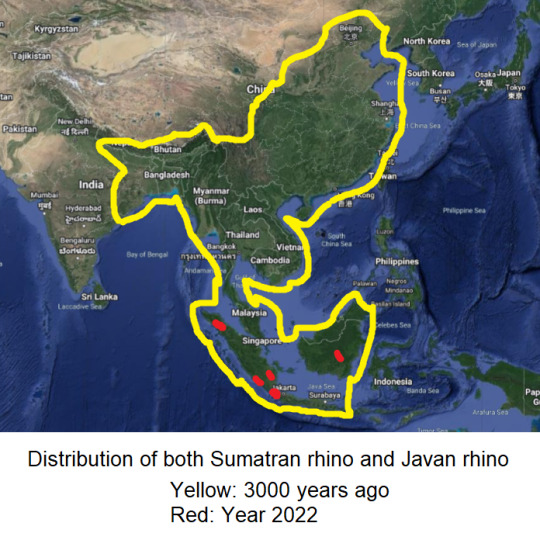
---
Anyway, in the Middle East, for those interested:
What we do know for sure is that tigers, lions, cheetah, caracal, and at least 2 subspecies of leopard were all still alive in Levant, Anatolia, Mesopotamia, Kurdish land, the Caucasus, and Persia within the last 100-125 years.
Then, we also know that the Syrian ostrich (Struthio camelus syriacus) was historically present in Palestine, Syria, and Jordan during the 20th century. (During the medieval era, they probably still lived on the Arabian peninsula and western Persia. Gifts of ostriches were given to the imperial Han Chinese court by Parthians, and to Chinese courts by Western Turks in the 600s. Artistic depictions of ostriches still show up in Tang-era China, so ostriches were either still present in Bactria/Sogdiana, or they were present in Persia and shipped along the Silk Road.)
Crocodiles lived along the coastline of the eastern Mediterranean in Palestine into the 20th century. (Whether they were Crocodylus niloticus or Crocodylus suchus is hard to tell. Both species are still alive in Africa and both species were present in Egypt.)
Earlier in prehistory, we of course know about the wacky cave goats of Crete and the dwarf hippos of Mediterranean islands.
We also know that the Asian elephant was more widespread, and present in Anatolia and the Middle East during the Holocene.
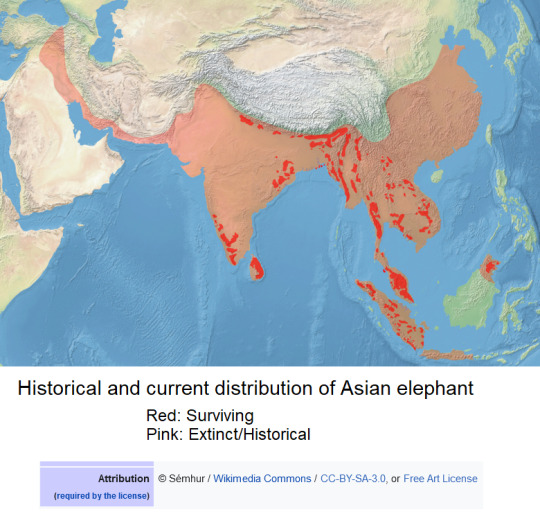
You might have guessed that the elephants known to Greeks and Romans would be the African elephant, given the strong connection between the Hellenistic Mediterranean cultures and Egypt. However, it seems that the Asian elephant that was better known in the eastern Mediterranean. There appears to have been a morph or subspecies of Asian elephant that lived along the Persian Gulf’s northern shore (the "Syrian elephant"). Asian elephant remains from the Holocene have been found in Anatolia and Kurdish lands. In the eastern Mediterranean, Assyrian kings boasted of trapping elephants for sport as recently as 3000 years ago. Also, consistent trade and cultural exchange from Persia meant that the Mediterranean peoples had an awareness of Indian/South Asian relationships with elephants.
---
Regarding forests:
The fame of cedar trees in Phoenicia (eastern Mediterranean) would explain why Phoenicians could become so well known for boat-building (ships require wood). More widespread forests would also explain why Caspian tigers could be present in what is now modern-day Iraq and Kurdish land.
Translations of ancient Near Eastern texts discuss woodlands. You’ve probably seen me share this excerpt before:
---
While some texts simply allude to environmental degradation, such as the Sumerian gardener Shukallituda’s experimentation with agroforestry in the wake of deforestation ... others contain explicit description of forest clearance, including the claim of Gudea of Lagash (2141-2122 BC), who “made a path” into the forest, “cut its cedars,” and sent cedar rafts floating “like giant snakes” down the Euphrates” [...]. Despite declining biological diversity and productivity, the annals of Ashurnasirpal II [king of Assyria from 883 to 859 BC] describe abundant wildlife and a substantial inventory of domesticated livestock. He claimed to have slain 450 lions, killed 390 wild bulls, decapitated 200 ostriches; caught thirty elephants in pitfalls; and captured alive fifty wild bulls, 140 ostriches, and twenty adult lions. In addition, he received five live elephants as tribute, and “organized herds of wild bulls, lions, ostriches, and male and female monkeys.” At a banquet on the occasion of the inauguration of the palace at Kalhu (biblical Calah), his 69,574 guests dined on 1200 head of cattle and 1000 calves; 11,000 sheep and 16,000 lambs; 500 stags; 500 gazelles; 1000 ducks; 1000 geese; 1000 mesuku birds, 1000 qaribu birds, 20,000 doves, and 10,000 other assorted small birds; 10,000 assorted fish; and 10,000 jerboas - along with enormous quanitites of beer and wine, milk, cheese, eggs, bread, fruit and vegetables, and a vast number of other offerings.[...] Hence, many Indigenous societies were disrupted, reconfigured, and dominated prior to formal colonial annexation. The costs of declining biological and cultural diversity are well documented, as are the costs of disturbance and domination in natural and social systems. A Sumerian epic tale, ‘Emmerkar and the Land of Aratta,’ describes an earlier state of peace and security, ending with man’s fall from grace. Descent into chaos is described in the epic, ‘Lamentation over the Destruction of Sumer and Ur.’ In Western Asia, patterns of [ecological] disturbance and [social] domination emerge with the complex interplay of ascendant Egyptian, Caucasian, Semitic, Indo-European, and Dravidian aristocracies in the fifth millennium BC – patterns that cascade through history.
[End of excerpt.]
Source: Jeffrey A. Gritzner. “Environment, Culture, and the American Presence in Western Asia: An Exploratory Essay.” 2010.
---
And yes, I’d say that recent Holocene extinctions in the region would be related to deforestation, at least in the case of the Caspian tiger.
The Caspian tiger had a clear association with the Hyrcanian forests of the southern shore of the Caspian Sea in Persia. These forests resemble temperate rainforests. The distribution of the Caspian tiger throughout Sogdiana and Kwarazmia (modern-day Turkmenistan and Uzbekistan) also seemed closely associated with the Amu Darya and Syr Darya river/riparian corridors, which provided narrow avenues of forested habitat amid the vast deserts of the region. During the imperial Russian and Soviet incursions in Central Asia, when irrigation diverted the rivers for industrial-scale agriculture, the Aral Sea dried up and remaining pockets of woodland were destroyed along with the tiger’s habitat.


The cedar forests of the Fertile Crescent probably hosted oryx and gazelles with nearby populations of Syrian elephant, the Syrian ostrich, the Asiatic lion, cheetahs, leopards, and the Caspian tiger.
Assyrian princes caught elephants in pitfall traps for sport. It was over 4000 years ago that kings ‘“made a path” into the forest, “cut its cedars,” and sent cedar rafts floating “like giant snakes:” down the Euphrates”’
The tiger. Now a ghost. Gone along with the forests.
92 notes
·
View notes
Text
One Last Night
Relationship: Alluri Seetharamaraju/Komuram Bheem
Rating: T
Tags/warnings: soulmarks, slight angst from audience pov
CelebRRRation Day Two - Soulmates ~ Misunderstandings ~ Animals
Bheem’s heart races as he quickly but steadily pours his herbal concoction into Raju’s mouth. He knows the danger is gone, that the poison in the krait bite has been neutralized, but it hurts to think about how close Bheem was to losing his best friend. If Raju had gone anywhere other than the area Bheem was at, he would’ve died in the next few minutes.
Had he known? Bheem wonders. That I would’ve been able to save him from a poisonous snake bite?
No, there’s no way. Bheem had been careful to conceal his identity, even lying about his soulmark.
His heart starts beating faster at the thought, this time out of hope and excitement. As he was checking Raju’s right arm, he had glanced upon his visible soulmark. Usually both he and Raju kept theirs concealed, like many others in the world, but this time both of Raju’s arms were uncovered. Glistening upon Raju’s right wrist was his own true soulmark, an Indian elephant. He sneaked a glance at Raju’s left arm to find a Sumatran tiger.
At the time, Bheem put it out of his mind in order to save Raju, but now, as he deposits Raju onto his own bed, he finds that he can’t stop thinking about it.
Raju and Bheem are soulmates.
He had hoped so much in the initial days of their friendship that they shared the same soulmark. He and Raju seemed to connect in a way that Bheem had never done with anyone back home. Raju was an enigma, a source of knowledge. He was good at many things, and a great teacher. Raju could also be short-tempered, stubborn, and was absolutely shitty at cooking, but Bheem loved all parts of Raju’s personality.
He was crushed when he had shyly asked about Raju’s soulmark, and Raju had answered that his own was a horse, while his soulmate’s animal, on his right wrist, was a persian cat. Bheem did not have a horse on his right wrist, nor a cat on his left wrist. Raju had hesitantly asked about Bheem’s in return. Knowing he couldn’t reveal his true marks, Bheem had lied and said he had a rabbit and a peacock on his left and right wrists, respectively. Raju seemed disappointed, but the topic was quickly forgotten.
Bheem had put the incident out of his mind, resolving to just love his Raju from a distance and show him nothing but true friendship, until today, when he saw his own soulmark on Raju’s wrist.
Raju had lied about his soulmark, too. Why?
It didn’t matter. Whatever the reason, their soulmarks matched. He knew Raju saw him as a close friend, given he had made his way over to Bheem when he thought he was dying, and he probably would be happy to know Bheem was his soulmate.
But they couldn’t keep going on a relationship of lies. It was Bheem’s duty to tell Raju the truth about himself. If he couldn’t trust Raju, the man he loved the most, then who could he trust?
He clasps Raju’s hands as he starts talking. “Anna. I’m not Aktar, nor a Muslim man.” Bheem watches Raju’s eyes widen, but he’s not worried. Even if Raju was angry at him for lying, he knows once Raju finds out he’s doing all of this to save a child, Raju would be on his side. He’s seen the way the other man panicked when he saw a little boy in water and was willing to do anything to save him. Why wouldn’t he feel the same for a little girl being kept in a cage?
“Bheem.” His own name is jarring to say, after months of keeping it from Raju, but suddenly he longs to hear it from Raju’s mouth. How would it sound, the name of one of his gods?
“I’m a child of the Gonds.” He knows there’s pride in his voice, but he can’t help it. He’s excited to share this part of himself, to his soulmate. He can’t wait to show Raju his traditions, his tattoos.
He explains about Malli and his mission, and he assures Raju everything will be fine once he comes back. Raju is looking at him with a lost expression as he leaves, and Bheem assumes it’s the shock of this newfound knowledge. It’s okay, the man had just gotten poisoned. Raju will fall asleep soon, Bheem can complete his mission, and they can all talk in the morning. He can introduce his soulmate to his sister, and figure out what to do next since Bheem will be a wanted man.
Maybe Raju can come with him to his tribe? He has never seen Raju talk to anyone other than his babai, so it doesn’t seem like Raju has friends or other family. The Gonds would love him, especially Krishnammavva. She would remark on how thin Raju was, Bheem thinks fondly, and try to feed him extra laddoos. Surekha would be ecstatic that there would be another wedding in the tribe soon, and his favorite mamas would tease Bheem endlessly over how he met his soulmate and then lied to him.
Bheem leaves the house with a smile on his face, knowing this night will change his whole life.
-
@celebrrration
35 notes
·
View notes
Text

Sumatran Elephant Elephas maximus maximus
Family: Elephantidae
Genus: Elephas
Conservation Status: Critically Endangered
Working on this one was a real challenge. The lighting of the photo was difficult to figure out, and the shapes on the head were at an angle that I wasn't familiar with. Anyway, the outcome got me satisfied. I had no idea about this subspecies until I got to study elephants. Very interesting subspecies.
Join the club to know more about this and more animals. Also, you can get access to the book in the making and the Esticker album.
Click here
____________________________________________
Thank you guys for your support. If you like the content please like and subscribe. Deeping into animals that we think we know every week
#elephant#sumatran elephant#elefante#illustration#drawing#scientific illustration#illo#wild animals#artist on tumblr#wildlife#animals#mammals#cute animals drawing#conservation#critically endangered#endangered species#infographic#infografía#asian elephant#animal
31 notes
·
View notes
Text

A female baby Sumatran elephant stands near her mother and sibling at Conservation Rescue Unit Alue Kuyun in the Aceh Barat district of Aceh province, Indonesia
Photograph: Xinhua/Shutterstock
#xinhua#photographer#shutterstock#sumatran elephants#elephants#animal#mammal#wildlife#conservation rescue unit alue kuyun#aceh barat district#aceh province#indonesia#nature
23 notes
·
View notes
Photo

[ A female Sumatran rhinoceros, photographed by Cyril Ruoso. ]
“There is little doubt about the threats to Indonesia’s biodiversity. Sumatra, home to six critically endangered, iconic mammalian species found nowhere else—the Tapanuli orangutan, the Sumatran orangutan, the Sumatran tiger, the Sumatran rhinoceros, and the Sumatran elephant—has lost more than 80% of its lowland forests since the 1990s, to make room for pulpwood and oil palm plantations. Conflicts between humans and wildlife have become increasingly common. News stories frequently report elephants poisoned by angry farmers, tigers snared by poachers, and orangutans stranded in plantations.
Scientists and nongovernmental organizations (NGOs) say producing reliable population estimates and mapping remaining habitats are crucial to conservation. The environment ministry’s provincial conservation agencies (BKSDA) and national park rangers have supported such work on the ground, for example by counting orangutan nests, collecting elephant dung samples, and setting camera traps for tigers. But researchers say KLHK’s headquarters has kept data from such efforts under wraps.
Wulan Pusparini, an Indonesian wildlife conservationist at the University of Oxford, says her DNA-based population survey has shown the elephant population in a national park in southern Sumatra declined by 75% between 2001 and 2015. Provincial BKSDA officials were “very supportive” when she presented those data in 2018, she says, “but it got stuck in Jakarta.” KLHK’s central office has not allowed her to publish the findings, Pusparini says.
In 2020, the Sumatran Elephant Conservation Forum, a consortium of scientists and conservationists from various NGOs and BKSDA offices, produced what it called an Urgent Action Plan describing remaining elephant populations, the threats they face, and how they could be protected. KLHK’s director of conservation signed and released the document, but the ministry retracted it a year later. Among the reasons was what KLHK called “a counterproductive statement against the government” in the plan.
Studies on other species have met a similar fate. KLHK has not approved a consortium’s estimate for Indonesia’s tiger population, submitted in 2016; the data remain unpublished. (“It is the best available knowledge so far,” says an Indonesian member of the team.) The ministry also disputes a recent report from a specialist group at the International Union for Conservation of Nature that estimates there are fewer than 50 Sumatran rhinos left in the wild. KLHK says it’s between 67 and 75.
As to orangutans, the op-ed by Meijaard and his colleagues took issue with an upbeat assessment by KLHK Minister Siti Nurbaya on World Orangutan Day, on 19 August. The minister stressed Indonesia’s commitment to conservation but said all three species in the country—including the Tapanuli orangutan, whose existence is threatened by a hydropower project in North Sumatra—would continue to “grow and thrive.” Yet “A wide range of scientific studies … show that all three orangutan species have declined in the past few decades and that nowhere are populations growing,” the authors countered in The Jakarta Post.”
- Excerpt from “Indonesia bans five foreign scientists, shelves conservation data” by Dyna Rochmyaningsih.
50 notes
·
View notes
Note
If you had to live in any part of Essos, where would you live?
For obvious reasons, it’d have to be a place with no slavery (or at least not mentioned), no cannibals/demons, no obvious diseases, as well as clean water and permanent housing. That narrows it down quite a bit.
There’s Braavos, which is technologically advanced, an arts/science center, has religious tolerance, several famous landmarks, a good bank…however, there’s no trees, shadow assassins will hunt you down if you don’t pay on time, and everything is expensive.
There’s the sister cities of the Patrimony of Hyrkoon, where girls are trained from a young age to be warriors, it has thick fortified walls, a thriving trading system…on the other hand, it sacrificed thousands of Jhogos Nhai to their gods to win a war against them.
Saath has an interesting history being the last remnant of a great kingdom, caught between the Dothraki and Valyrians but adopting none of their ways wrt slavery, they breed amazing horses, they’ve survived on trade with Lorath and Ib…but it’s not a secure area, the people are not friendly to outsiders and they’re tall.
Then there’s the Isle of Elephants, their biggest city Zabhad is part of the trader’s circle, it’s close to the “paradise island” Marahai, their ruler lives in a palace of ivory (sure they do, Corlys. It’s not like ivory is incredibly dense and rare making building a permanent palace impossible)…and it has many elephants. Since it’s not a big island I assume they’re pocket elephants such as the Bornean and Sumatran elephants irl. I see no drawbacks to living in this place thus far.

33 notes
·
View notes
Text

This is the forest European rhinoceros "Merka". He lived next to the forest elephant, the European hippopotamus and the water buffalo. Unlike most modern rhinos, it was covered in hair and looked like a Sumatran rhinoceros.



#Ice age paleoart#The Merck's rhino large canvas wall art prints#Excellent coworker gift#fathers day gifts#anniversary gift#With this original artwork you'll have exclusive office or dining room wall art#rustic decor#animal wall decor#wildlife#landscape#nature#kolyma woolly rhino#Coelodonta antiquitatis#permafrost#Woolly rhinoceros#paleontology#prehistoricfauna#extinct animal illustration#extinción#recently extinct#extinct animals
6 notes
·
View notes
Text






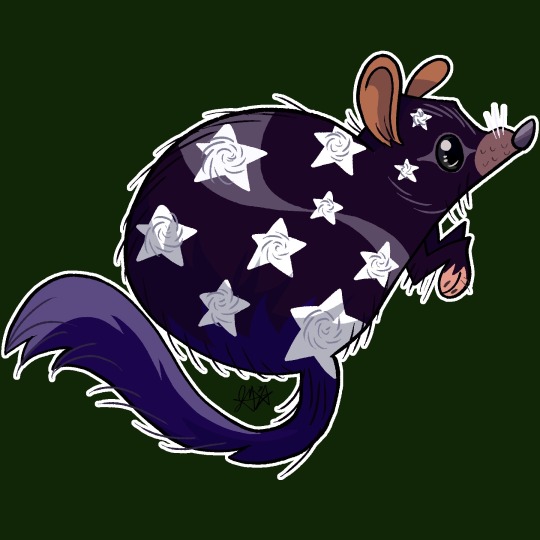



You made it to the end of the week! Congrats!! Here some funky children to celebrate!!
Today’s kids are:
Bubble tip Anemone
Sarada Lizard
Tasmanian Devil
Sumatran Striped Swamp Rabbit
Mushroom-Tongued Newt
Linsang
Eastern Quoll
Black and Rufous Elephant Shrew
Kiti's Hognose Bat
Bearded Vulture
21 notes
·
View notes
